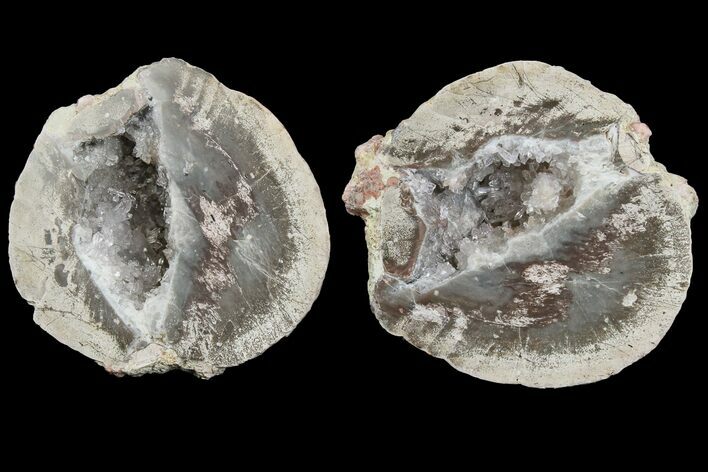This Specimen has been sold.
2.65" Las Choyas "Coconut" Geode with Amethyst Crystals - Mexico
This is a beautiful "coconut geode" from Chihuahua, Mexico. This geode is filled with amethyst crystals and has been cut in half and polished to a glossy finish.
Geodes are rounded, hollow voids in rocks filled with crystals and other minerals. They typically form when air bubbles inside of volcanic rock form hollow cavities. Over time, as mineral-rich water seeps into the rock, those minerals deposit tiny crystals on the sides those hollow cavities. After millions of years, the flow of water gradually builds crystals inside the empty space.
Las Choyas geodes, often referred to as coconut geodes, are mined from 100 to 200 feet below the surface near Chihuahua, Mexico. Shafts are drilled down to the geode-bearing white clay, and then tunnels are dug horizontally to extract the geodes.
The geodes typically range from about 2-6 inches in diameter and can contain a variety of minerals and crystals. Most hollow geodes contain a variety of quartz, ranging from clear quartz to smoky quartz to rarer amethyst. Many secondary minerals, such as goethite, hematite, mordenite, calcite and galena, may also be present in some geodes.
Las Choyas geodes, often referred to as coconut geodes, are mined from 100 to 200 feet below the surface near Chihuahua, Mexico. Shafts are drilled down to the geode-bearing white clay, and then tunnels are dug horizontally to extract the geodes.
The geodes typically range from about 2-6 inches in diameter and can contain a variety of minerals and crystals. Most hollow geodes contain a variety of quartz, ranging from clear quartz to smoky quartz to rarer amethyst. Many secondary minerals, such as goethite, hematite, mordenite, calcite and galena, may also be present in some geodes.
Amethyst is a purple variety of quartz (SiO2) that owes its violet color to natural gamma irradiation, iron impurities, and the presence of trace elements, which result in complex crystal lattice substitutions. It is considered a semi-precious gemstone, and just two centuries ago was considered to have a value on par with diamonds, sapphires, and rubies. The largest and best known amethyst deposits occur in southern Brazil and Uruguay, where they are found in hydrothermally-formed geodes, but many localities around the world produce an amazing variety of amethyst crystals and formations. They are almost always formed in medium- to high-temperature geological settings.
SPECIES
Quartz var. Amethyst
LOCATION
Chihuahua, Mexico
SIZE
2.65" wide
CATEGORY
SUB CATEGORY
ITEM
#165395
 Reviews
Reviews














